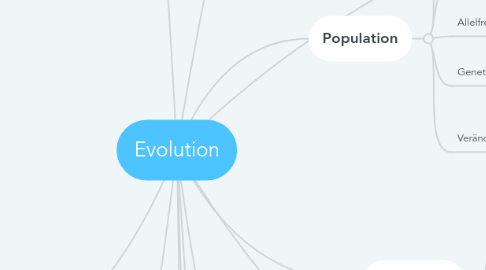
1. Koevolution
1.1. Mutualistisch
1.2. Antagonistisch
2. Isolation
2.1. Präzygotisch
2.1.1. Geographisch
2.1.2. Ökologisch
2.1.3. Ethologisch
2.1.4. Zeitlich
2.1.5. Mechanisch
2.1.6. Gametisch
2.2. Postzygotisch
2.2.1. Hybrid Sterblichkeit
2.2.2. Hybridsterilität
2.2.3. Hybrid Zusammenbruch
3. Variation
3.1. Variation durch Rekombination
3.1.1. interchromosomale Rekombinatin
3.1.2. Intrachromosomale Rekombination
3.1.3. Gameten
3.1.4. Meiose
3.1.5. Prophase 1
3.1.6. Crossing Over
3.2. Genotyp
3.3. Phänotyp
3.4. Abiotische Faktoren
3.5. Biotische Faktoren
3.6. Modifikation
3.6.1. Nicht erblich
3.7. Mutation
3.7.1. Erblich
3.7.2. positiv
3.7.3. negativ
3.7.4. neutral
3.7.5. Mutationsrate
3.8. Neue Idee
4. Fortpflanzungsstrategien
4.1. Paarungssysteme
4.1.1. Monogamie
4.1.2. Polygamie
4.1.2.1. Spermienkonkurrenz/ sperm competition
4.1.2.2. Neue Idee
5. Koorperationen/ Mutualismus
5.1. Endosymbiose
5.1.1. Endosymbiontentheorie
5.2. Ektosymbiose
5.2.1. Clownfisch-Anemonen
6. Individualselektion
6.1. Altruismus
6.1.1. Reziprokem Altruismus
7. Selektion
8. Artbildung
8.1. Mimese
8.2. Mimikry
8.3. Allopatrische Artenbildung
8.4. Sympathische Artenbildung
8.5. Adaptive Radiation
8.5.1. Ökologische Nischen
8.5.2. Konkurrenz
9. Selektion
9.1. Selektionsdruck
9.1.1. Selektionskoeffizient
9.1.2. Abiotische Selektionsfaktoren
9.1.2.1. Wind
9.1.2.2. Licht
9.1.2.3. Etc.
9.1.3. Biotische Selektionsfaktoren
9.1.3.1. Fressfeinde
9.1.3.2. Parasiten
9.1.3.3. Artgenossen
9.1.3.3.1. Konkurrenz
9.1.3.4. Mensch
9.1.3.4.1. Industriemelanismus
9.1.3.5. Etc.
9.2. Natürliche Selektion
9.2.1. Sexuelle Selektion
9.2.1.1. Intersexuelle Selektion(intersexual selection)
9.2.1.1.1. Selektionsfaktoren
9.2.1.2. Intrasexuelle Selektion
9.2.1.2.1. Mate competition
9.3. Gerichtete Selektion
9.4. Stabilisierende Selektion
9.5. Disruptive(Aufspaltende) Selektion
9.6. Ergebnis: Adaption (Angepassung)
9.6.1. Neue Idee
10. Theorien
10.1. Lamarck
10.1.1. Häufiger Gebrauch stärkt Organ
10.2. Darwin
11. Population
11.1. Individuum
11.1.1. Homozygot(AA/aa)
11.1.2. Heterozygot(Aa)
11.2. Fortpflanzungsgemeinschaft
11.2.1. Genpool
11.3. Allelfrequenz
11.3.1. Allel
11.3.1.1. Dominant(A)
11.3.1.2. Rezessiv(a)
11.4. Genetische Struktur
11.4.1. Genotyp
11.5. Veränderung durch Zufall
11.5.1. Migration/Wanderung
11.5.1.1. Genfluss
11.5.2. Gründereffekt
11.5.3. Flaschenhalseffekt
11.5.3.1. Gendrift
12. Belege
12.1. Fossilien
12.2. Knochen
12.3. Mumifikation
12.4. Steinkern
12.4.1. Neue Idee
12.5. Anatomie/Morphologie
12.5.1. Homologie
12.5.1.1. Kriterium der Lage
12.5.1.2. Kriterium der spezifischen Qualität
12.5.1.3. Kriterium der Stetigkeit
12.5.2. Analogie/Konvergenz
12.5.2.1. Neue Idee
